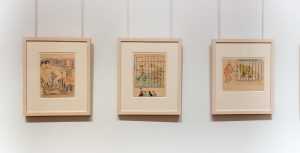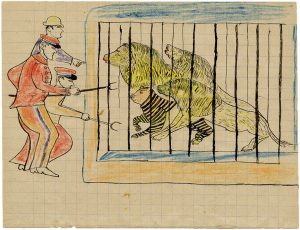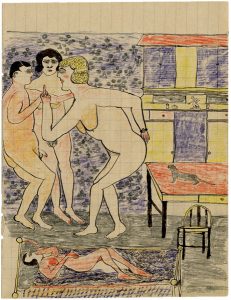EXHIBITIONS

Grapes Lost and Found
Exhibition:
June 17 – July 21, 2020
11am – 6pm | mon – fri
Maximilianstraße 26, 80539 München
In a recent conversation I had with Billy Al Bengston (Link to Bio), he quoted his racing buddy: “If it only costs money, it’s cheap.” Being an avid collector myself (although not of Contemporary Art) my interpretation of his words is: It can take a lot of effort, time and money to track down a specific object. Sometimes it can take years and money can’t help.
We had an exhibition of large Lüpertz (Link to Bio) paintings from 1967-70 at Art Basel in 2005. The paintings were huge. The show looked stunning and was a great success. The painting “Weintrauben” did not find a place in the show of tree trunks, telegraph poles and tunnels and remained upstairs in storage to return with the other works to Germany after the fair. But it never arrived. We only realised it had gone missing about a year later when a loan request for the work came and we couldn’t locate it.
Now 15 years later a friend sends me this cryptic text message: “Dear Daniel, tell me, are you missing a grape painting? I hope you are well. Best wishes…”
It turns out that the crate with our label still on it mysteriously turned up in a private furniture warehouse in Munich. The owner of that warehouse is a friend of our friend. I thought “Great! The grapes are back.” But then the finder emailed: “How can I be sure you are the owner? I think I’d better go to the police.” Days of silence followed. The painting had vanished again. Then somebody within the city’s Lost and Found department called up. He had been referred to us by the Lenbachhaus, and wondered if we dealt in Lüpertz? “There is this painting someone found…”
I am sure that many of the artworks we enjoy today would have fascinating stories to tell, if only they could speak to us in words as well as with their beauty. I thought this lucky moment merited a presentation on the theme of flora and color.
Karl-Heinz Schwind (Link to Bio) was our first exhibition when we opened some 30 years ago. His works are pure energy.
Eugène Leroy (Link to Bio), who sometimes worked for several years on a painting before considering it finished, Don van Vliet, cult musician and painter and Billy Al Bengston, known for his tropical themes and vivid colors, are well known and do not need my introduction.
David Byrd is neither “Insider” nor “Outsider”. Having studied art after WWII under Amédée Ozenfant he only developed his mature style and produced his most defining body of work after he started working as an orderly at a hospital psychiatric ward, from 1958-88.
His paintings defy any of the “Isms” we usually like to apply to art we see; they stand apart from Pop, Realism or Expressionism. If anything I would refer to his work as New York Surrealism. Byrd’s works have an airy and somewhat evanescent quality, as if viewed through a milky glass.
Guerle and Nény were true self-taught artists who remained more or less in obscurity but whose visual languages are equally inspiring and distinctive as the better-known artists in our exhibition. They only came to my attention through writers like Hans Prinzhorn or Dr. Jean Lacassagne, who were interested in and propagated the artistic output of mentally insane or criminal individuals. Prinzhorn’s Bildnerei der Geisteskranken (Berlin 1922) and Albums du Crocodile by Lacassagne (Lyon 1939) have been rare sources of information on these fascinating artists.



























 +49 89 29 73 42
+49 89 29 73 42